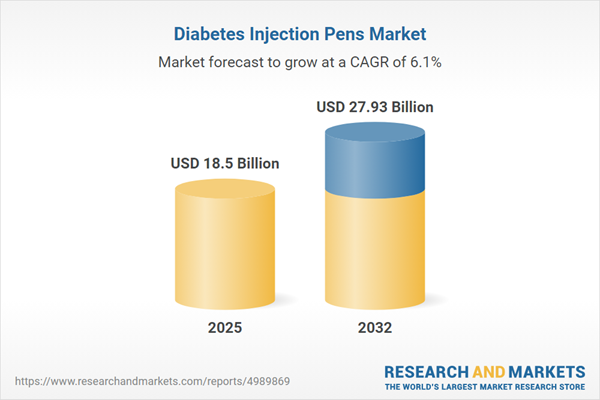Speak directly to the analyst to clarify any post sales queries you may have.
Senior executives in healthcare, medtech, and pharmaceutical industries are facing an evolving diabetes injection pens market shaped by ongoing device innovation, new digital integration demands, and shifting care models. With disruptive changes in technology and regulation, actionable market insights are critical for confidently identifying high-growth strategies and strengthening operational readiness.
Market Snapshot: Diabetes Injection Pens Market Growth and Dynamics
The Diabetes Injection Pens Market expanded from USD 17.46 billion in 2024 to USD 18.50 billion in 2025, and is on course to reach USD 27.93 billion by 2032, reflecting a CAGR of 6.05%. This trajectory is propelled by the rising global diabetes burden, increasing implementation of digital therapy management, and growing collaboration among manufacturers and healthcare providers. Executives are revisiting value creation strategies in the Diabetes Injection Pens Market in response to heightened competition and rapidly advancing connected health device solutions.
Scope & Segmentation: Comprehensive Market Coverage
- Technology: Addresses both conventional and smart pens, spanning mechanical designs and sensor-enabled devices for connectivity and advanced management.
- User Type: Offers analysis for Type 1 and Type 2 diabetic populations, providing context for varied patient needs, usage scenarios, and clinical pathways.
- Insulin Type: Examines analog and human insulin pens, highlighting their therapeutic impact and implications for cost-effectiveness in care delivery models.
- Product Type: Covers prefilled and reusable pens, with a focus on user convenience, environmental factors, and shifting institutional preferences for device procurement.
- Distribution Channel: Evaluates hospital, online, and retail pharmacy access points, reflecting how patient engagement and provider workflows are changing across markets.
- End User: Assesses clinics, homecare, hospitals, and pharmacies, emphasizing the customized adoption requirements and workflow integration priorities unique to each setting.
- Therapy Type: Reviews long-acting, premixed, and rapid-acting insulin pen therapies, considering alignment with patient profiles, intensity of disease management, and delivery efficiencies.
- Geographic Regions: Analyzes Americas (including United States, Canada, Mexico, Brazil, Argentina, Chile, Colombia, Peru), Europe (including United Kingdom, Germany, France, Russia, Italy, Spain, Netherlands, Sweden, Poland, Switzerland), Middle East (such as United Arab Emirates, Saudi Arabia, Qatar, Turkey, Israel), Africa (including South Africa, Nigeria, Egypt, Kenya), and Asia-Pacific (covering China, India, Japan, Australia, South Korea, Indonesia, Thailand, Malaysia, Singapore, Taiwan).
- Company Coverage: Highlights Novo Nordisk A/S, Eli Lilly and Company, Sanofi S.A., Becton, Dickinson and Company, AstraZeneca PLC, Ypsomed Holding AG, Owen Mumford Limited, Biocon Limited, HTL-Strefa S.A., and Gerresheimer AG as principal market players shaping competitive direction and supply chain standards.
Key Takeaways: Strategic Insights for Decision-Makers
- Industry momentum is strong for smart pen adoption, as device connectivity and real-time data catalyze improved patient adherence in both clinical and home settings.
- Shifting regulatory environments are rewarding rigorously validated device innovation, helping integrated solutions reach markets faster and with broader acceptance.
- Reusable pen solutions are growing in demand, prompted by sustainability initiatives and evolving patient priorities in procurement decisions for healthcare systems.
- Distribution trends indicate rising importance of online and retail pharmacies in delivering patient-centric support, while institutional channels emphasize information flow and data compatibility.
- Manufacturer agility and responsive supply chain partnerships are increasingly essential for addressing disruptions and adapting to region-specific tariffs or policy changes.
Tariff Impact: Navigating U.S. Trade and Supply Chain Shifts
The 2025 implementation of additional tariffs in the United States is influencing sourcing and cost structures throughout the Diabetes Injection Pens Market. Organizations are accelerating efforts to nearshore assembly, diversify their supplier portfolios, and engage local partners, building resilience against shifting geopolitical and trade landscapes.
Methodology & Data Sources
This comprehensive study utilizes primary insight from leading industry and clinical stakeholders, alongside secondary sources such as regulatory filings, journals, patent literature, and market publications. Each finding is cross-verified for reliability and accuracy to provide senior leaders with robust, actionable intelligence.
Why This Report Matters
- Delivers an in-depth segmentation framework supporting commercial, regulatory, and procurement strategies for senior executives in a highly dynamic landscape.
- Clarifies regulatory trajectories, empowering leadership to synchronize product portfolios and market entry timing with evolving compliance requirements.
- Provides forward-looking intelligence on digital disruption and distribution channel transformation, informing approaches to supply chain risk and margin protection.
Conclusion
The Diabetes Injection Pens Market will continue to evolve as digital integration, responsive supply strategies, and patient-focused innovation reshape global delivery of diabetes care. Prioritizing technology, resilience, and strategic market alignment is essential for sustainable, long-term growth.
Additional Product Information:
- Purchase of this report includes 1 year online access with quarterly updates.
- This report can be updated on request. Please contact our Customer Experience team using the Ask a Question widget on our website.
Table of Contents
3. Executive Summary
4. Market Overview
7. Cumulative Impact of Artificial Intelligence 2025
List of Figures
Samples

LOADING...
Companies Mentioned
The key companies profiled in this Diabetes Injection Pens market report include:- Novo Nordisk A/S
- Eli Lilly and Company
- Sanofi S.A.
- Becton, Dickinson and Company
- AstraZeneca PLC
- Ypsomed Holding AG
- Owen Mumford Limited
- Biocon Limited
- HTL-Strefa S.A.
- Gerresheimer AG
Table Information
| Report Attribute | Details |
|---|---|
| No. of Pages | 186 |
| Published | October 2025 |
| Forecast Period | 2025 - 2032 |
| Estimated Market Value ( USD | $ 18.5 Billion |
| Forecasted Market Value ( USD | $ 27.93 Billion |
| Compound Annual Growth Rate | 6.0% |
| Regions Covered | Global |
| No. of Companies Mentioned | 11 |









